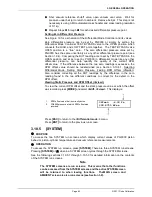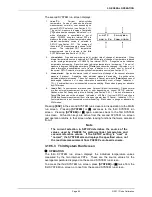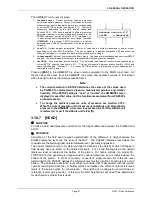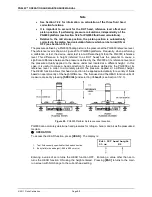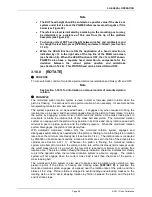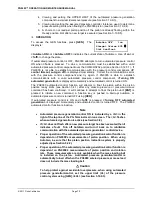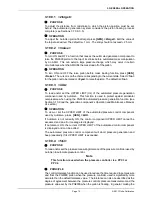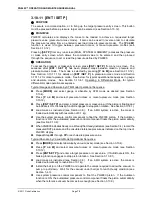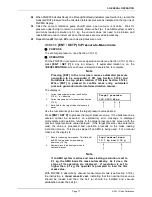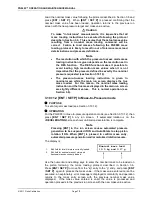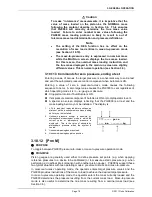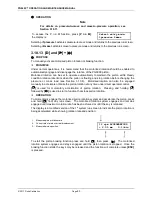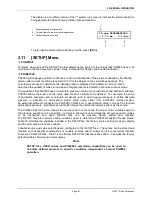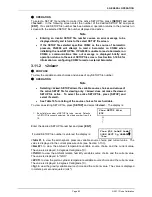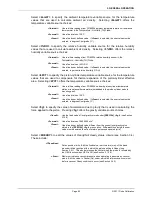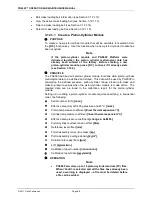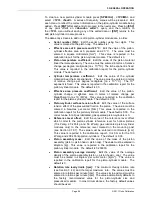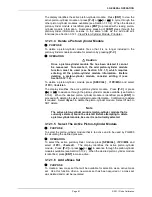
PG9602™ OPERATION AND MAINTENANCE MANUAL
© 2011 Fluke Calibration
Page
76
3.10.11 [ENT / SET P]
PURPOSE
To execute a command option, or to bring up the target pressure entry screen. This button
must be pressed before a pressure target can be entered. (see Section 3.10.12).
PRINCIPLE
PG9000 calculates and displays the mass to be loaded to achieve a requested target
pressure value (
pressure-to-mass
mode). It also can be used in reverse order to calculate
the pressure resulting from an entered mass load (
mass-to-pressure
mode). The
[P
OR
M]
function is used to toggle between
pressure-to-mass
or
mass-to-pressure
modes (see
Section 3.10.12).
Pressing
[SET P]
from any run screen (MAIN, SYSTEM or AMBIENT) accesses the pressure
or mass entry screen which allows the command value to be entered, and then proceed
through the sequence to set or read the pressure defined by PG9000.
OPERATION
To access the pressure or mass entry screen, press
[ENT / SET P]
from any run screen. The
sequence after
[ENT / SET P]
has been pressed varies between
mass-to- pressure
and
pressure-to-mass
mode. The mode is selected by pressing
[P
OR
M]
(see Section 3.10.12).
See Section 3.10.11.1 for details on
[ENT /SET P]
in
pressure-to-mass
mode and Section
3.10.11.2 for
mass-to-pressure
mode. See below for typical operational sequences in gauge
and absolute modes. See Section 3.10.4.1, Operating in Differential Mode, for typical
differential mode operational sequence.
Press
[MODE]
and select gauge or absolute by ATM mode as desired (see Section
Typical Gauge and Absolute by ATM Mode Operational Sequence:
Press
[P
OR
M]
and select
pressure-to-mass
or
mass-to-pressure
mode (see Section
Press
[ENT / SET P]
and enter a target pressure or mass value. (If the piston is floating and
AutoRoate is ON, the braking function engages to stop piston rotation. See Section 3.10.8.1).
Load mass as instructed (see Section 3.6). If an AMH system is active, the mass is
loaded automatically with resolution of 0.1 kg.
Use the system pressure control component to float the PG9000 piston. If the AutoGen
function is ON, the automated pressure control component floats the piston automatically
(see Section 3.10.9).
When PG9000 indicates
Ready
on all
Ready/Not Ready
indicators (see Section 3.4), record the
measured DUT pressure and the calculated reference pressure as indicated on the top line of
PG9000 display.
Repeat Steps
through
for each desired pressure value.
Press
[MODE]
and select absolute by vacuum (avac) mode (see Section
Typical Absolute by Vacuum Mode Operational Sequence:
Press
[P
OR
M]
and select
pressure-to-mass
or
mass-to-pressure
mode (see Section
Press
[ENT/SET P]
and enter a target pressure or mass value. (If AutoRoate is ON, the
braking function engages to stop piston rotation. See Section 3.10.8.1).
Load mass as instructed (see Section 3.6). If an AMH system is active, the mass is
loaded automatically to resolution of 0.1 kg.
Install the bell jar on the PG9000, and operate the valves required to allow the vacuum to
pump to pull down. Wait for the vacuum under bell jar to reach
Ready
condition (see
Section 3.4.3).
Use system pressure control component to float the PG9000 piston. If the AutoGen
function is ON, the automated pressure control component floats the piston automatically
when the reference vacuum becomes low enough (see Section 3.10.9).
Summary of Contents for PG9000 Series
Page 10: ...PG9602 OPERATION AND MAINTENANCE MANUAL 2011 Fluke Calibration Page X Notes...
Page 128: ...PG9602 OPERATION AND MAINTENANCE MANUAL 2011 Fluke Calibration Page 118 Notes...
Page 164: ...PG9602 OPERATION AND MAINTENANCE MANUAL 2011 Fluke Calibration Page 154 Notes...
Page 188: ...PG9602 OPERATION AND MAINTENANCE MANUAL 2011 Fluke Calibration Page 178 Notes...
Page 192: ...PG9602 OPERATION AND MAINTENANCE MANUAL 2011 Fluke Calibration Page 182 Notes...


